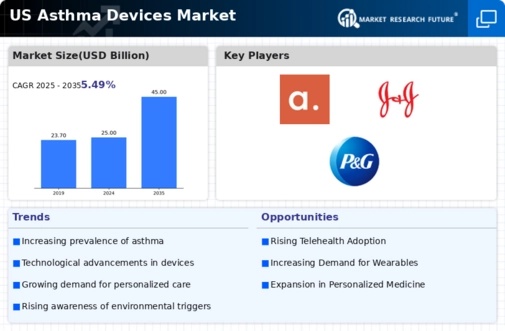Rising Prevalence of Asthma
The increasing prevalence of asthma in the US is a primary driver for the asthma devices market. According to the CDC, approximately 8.4% of adults and 7.5% of children are diagnosed with asthma, leading to a growing demand for effective management solutions. This rise in asthma cases necessitates the use of various devices, including inhalers and nebulizers, to ensure proper treatment. The asthma devices market is projected to expand as more individuals seek reliable devices to manage their condition. Furthermore, the financial burden associated with asthma-related healthcare costs, estimated at over $80 billion annually, underscores the need for effective devices that can alleviate symptoms and improve quality of life. As awareness of asthma management increases, the market is likely to see sustained growth driven by the need for innovative solutions.
Rising Healthcare Expenditure
The rising healthcare expenditure in the US is a critical factor driving the asthma devices market. With healthcare spending projected to reach $6 trillion by 2027, there is a growing emphasis on effective management of chronic conditions like asthma. Increased spending allows for the development and distribution of advanced asthma devices, which can lead to better patient outcomes. Moreover, as insurance coverage expands, more patients gain access to necessary devices, further propelling market growth. The asthma devices market is likely to see a surge in demand as patients seek affordable and effective solutions for managing their condition. This trend indicates a shift towards prioritizing respiratory health, which may lead to increased innovation and competition among manufacturers.
Increased Focus on Preventive Healthcare
The shift towards preventive healthcare in the US is influencing the asthma devices market positively. Healthcare providers are increasingly emphasizing the importance of early intervention and regular monitoring of asthma symptoms. This trend encourages patients to utilize devices that facilitate ongoing management of their condition. The asthma devices market is expected to expand as more individuals adopt preventive measures, such as using peak flow meters and digital inhalers, to monitor their respiratory health. Furthermore, the integration of telehealth services allows for remote consultations and monitoring, making it easier for patients to access care. This focus on prevention not only improves patient outcomes but also reduces the overall healthcare costs associated with asthma management.
Technological Innovations in Device Design
Technological innovations play a crucial role in shaping the asthma devices market. The introduction of smart inhalers, which track usage and provide reminders, has transformed how patients manage their asthma. These devices often connect to mobile applications, allowing for better monitoring and adherence to treatment plans. The market for smart inhalers is expected to grow significantly, with estimates suggesting a CAGR of over 15% in the coming years. Additionally, advancements in nebulizer technology, such as portable and battery-operated models, enhance patient convenience and accessibility. As manufacturers continue to invest in research and development, the asthma devices market is likely to benefit from improved device efficacy and user experience, ultimately leading to better health outcomes for patients.
Growing Investment in Healthcare Infrastructure
Investment in healthcare infrastructure in the US is a significant driver for the asthma devices market. As healthcare facilities upgrade their equipment and expand their services, the demand for advanced asthma management devices increases. Hospitals and clinics are increasingly adopting state-of-the-art nebulizers and inhalers to provide better care for patients. The asthma devices market is likely to benefit from this trend, as healthcare providers seek to enhance patient outcomes through improved technology. Additionally, government initiatives aimed at improving healthcare access and quality may further stimulate market growth. With an estimated $4 trillion spent on healthcare annually in the US, the allocation of funds towards respiratory care is expected to create opportunities for innovation and expansion within the asthma devices market.














Leave a Comment